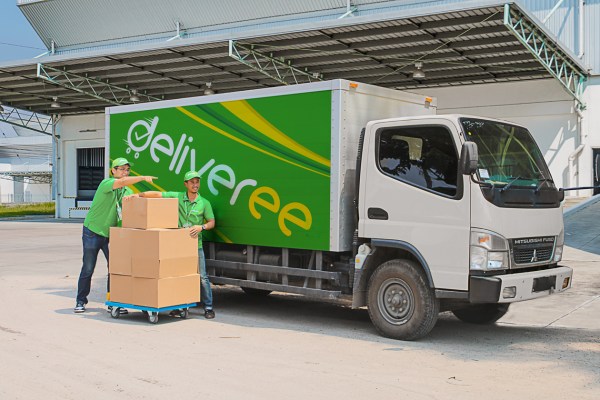Deliveree is smoothing Southeast Asia’s bumpy logistics landscape – TechCrunch
Logistics in much of Southeast Asia is not only complicated, but also expensive. Deliveree wants to solve that problem with a platform that not only lets clients book trucks, but also uses algorithms to determine the best route based on location, trucking loads and even the weather. The company announced today that it has raised a $70 million Series C led by Gobi Partners and SPIL Ventures, with participation from returning investor Inspire Ventures. This brings the company’s total raised so far to $109 million since it was founded in 2015.
The high cost of logistics means consumers end up paying higher prices, said founder and CEO Tom Kim. “The way we see the market is that number one, the inefficiency in trucking and cargo shipping has driven up costs materially. Imagine you’re in California, Los Angeles, and buying a pair of Nike shoes. What portion of that sales cost is spent on logistics and transportation and warehousing? The answer is very well-documented. It’s about 8%. If you buy those same Nike shoes in China, the answer is about 15%. And if you buy the same Nike shoes in Indonesia, Thailand or the Philippines, the answer is going to be much closer to 25%, maybe upwards of 30%.”
The company says that in the past 24 months, it has grown its gross transaction value by 3.2x and will exceed $100 million this year. It currently has 500 employees, and 100,000 drivers on its platform.
Deliveree is currently available in Indonesia, the Philippines and Thailand. It focuses primarily on large trucks that move commercial goods or large items. Kim said that based on Google Analytics, it gets more searched than other logistics companies. These include Waresix, Go Box, Kargo Tech and Logisly in Indonesia; Mober, Inteluck and TheLorry in the Philippines; and Giztik, TheLorry and Ezyhaul in Thailand.
Kim added that the logistics war is especially heated in Indonesia, where many logistics startups, like Waresix, have received funding.
“It’s where a lot of startups and disruptive technology in the space is being built, and it’s definitely a very active market,” he told TechCrunch. “There are all these well-known players, like Waresix or even Kargo Tech. The Philippines and Thailand are also interesting and great markets, but there are less players in the logistics space, especially cargo, trucking and freight.”
One of the problems that Deliveree solves is inefficient use of trucks. For example, trucks deliver a load of goods, but then return empty to the warehouses. If it’s part of Deliveree’s system, however, companies can book it to ship goods on its way back. That makes better use of the money spent on fuel, time and dispatch teams.
“There are an awful lot of empty trucks driving around in Thailand, the Philippine and Indonesia, because everyone has their own corporate fleets,” said Kim. “They do one-way delivery and the truck drives back empty. It’s even that way for long-distance deliveries, when you’re sending goods from one warehouse to some kind of facility in an other city. The same thing happens—you send the truck full one way and it comes back, sometimes hundreds of kilometers, empty.”
Deliveree solves these problems with a dynamic marketplace, that Kim says currently has tens of thousands of customers and vendors, including a combination of independent drivers and trucking companies. The marketplace’s technology, combined with its volume, can identify customers both ways on a truck’s journey so it rarely travels empty. The marketplace aggregates demand and determines optimal routes so trucks remain full. Kim said that before Deliveree came along, a 40% to 50% utilization rate was considered above average. With Deliveree’s marketplace, however, trucks can achieve up to a 80% utilization rate, thanks to Deliveree’s internally-generated data set, which is has been working on for five years.
“Even though it’s far from perfect, it gets smarter everyday because we do thousands of bookings every day, and it can make more accurate forecasts about the duration of the booking, the day of the week, the time of the day, even the weather. These are all things that have drastic impact on durations,” Kim said.
This also means warehouse has shorter waiting queues, because Deliveree’s algorithms can predict what loading and waiting times will be.
Most companies have their own fleets, which means hiring dispatch teams, admin teams, security teams, parking lots and security guards. This is still the prominent way it’s done, said Kim, and means a lot of overhead for companies. Kim said his argument when pitching Deliveree to companies is that they can de-leverage their balance sheets and book trucks on an asset-light basis like. That means they only pay for trucks when they need them. When the pandemic happened, revenue for many companies went down, and Kim said that led to more adoption of Deliveree as they tried to increase revenue. This increased adoption of Deliveree, as more companies tried to find ways to save money, to convert their fixed costs to variable costs.
Deliveree monetizes by charging a fee to the customer and splitting it with the carriers. Deliveree’s standard ratio is 80% to the independent trucker or trucking company, and a 20% commission for the company.
In a prepared statement, Gobi Partners managing director Kay Mok said, “Post-pandemic, we are moving into an inflationary environment plagued by supply chain issues. Deliveree has built the best tech platform for customers and this will enable them to optimize and lower total cost of operation for the logistics and shipping company.”




